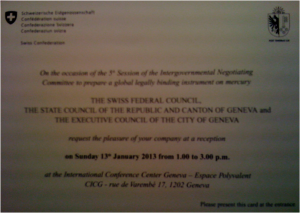This blog has been an incredible opportunity to share information about environmental policy and science from the broad institutional frameworks to the minute details of mercury chemical transport pathways. However, in 60 or so blog posts, it’s hard to encapsulate and communicate even a small percentage of the knowledge gained in preparing for and attending INC5. Instead of attempting a comprehensive summary, I’ll leave a few stray thoughts and reflections on the last few weeks.
I have always been allergic to chocolate, but never have I been so acutely aware of my immune system’s deficiencies than I was in Geneva. Chocolate is everywhere in Switzerland, and apparently it is delicious. Grocery stores have entire chocolate sections, and the flavors available range from the expected (hazelnut) to the bizarre (wasabi).
Reading peer-reviewed journal papers is insufficient when it comes to learning science policy. In the first day alone we saw scientists, government agencies, and NGOs use documentary film, personal narratives, long form journalism, and collective demonstrations as ways to share information. In the negotiations themselves, rhetorical metaphors were often more common than mentions of scientific models.
There is no such thing as a one-off negotiation in environmental policy. Every decision and every word choice in the treaty text was scrutinized for how it reflected historical precedence or how it would used to set a precedent in future treaties. When carving out a space for mercury regulation, linkages of concern are not just to already existing institutions but also to institutions that may exist in the future.
Perhaps someone needs to apply the inter- and cross-disciplinary systems-level approach in science and engineering to international policy and governance systems. Does it make sense to silo treaties into bins like “trade” or “human rights” when these issues are more closely interwoven? The dedicated article to health aspects in the mercury treaty, while its language may not be strong enough to compel parties to act, speaks to the need for a more comprehensive approach to environmental policy.
A Burger King Whopper is the cheapest meal at the Geneva Airport, and it will cost you $16. There is no dollar menu. Start saving now.
The treaty text does not adequately communicate the hard work, compromises, and nuanced deliberations that went into its crafting. As UNEP Executive Director Achim Steiner said after the text was adopted, “If people could see how hard delegates worked, maybe they would have a better appreciation for international treaties.” I agree with him, but I think it raises a question often asked of scientists: whose job is it to communicate this work?
I have a great idea for a science documentary/reality television show/educational experience. I’m not going to give out all the details because I don’t want somebody to steal it, but the title of the show is “SCIENCE TRAIN!” If you would like to produce it, feel free to contact me.


